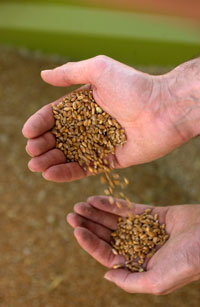Foliar disease top-up target for T3 sprays

Topping up foliar disease control with wheat fungicide ear sprays could be as important as minimising mycotoxin risk this season, a leading agronomist has warned.
“You need to get the balance right,” ProCam‘s David Ellerton told Farmers Weekly in a Syngenta-organised press call. “In recent seasons fusarium and mycotoxins have become the dominant issue, but they are not the only issue.”
Foliar diseases, such as Septoria tritici and rusts, could significantly damage yield, given the right weather, he pointed out, while specific ear disease, typically, had more impact on grain quality.
“It is worth controlling all of them,” he suggested.
Recent dry weather had led some growers to reduce flag leaf fungicide inputs because of perceived lower foliar disease pressure. But that could leave crops exposed to late Septoria tritici development if the dry spell ended, he said.
Crops also had to be protected from rusts, with more than 50% of varieties susceptible to either brown or yellow rusts. “That’s a major change from recent years.”
Warm and wet weather was needed for fusarium infection. “Typically in June we don’t reach the temperatures required for fusarium, which might be why mycotoxins are more of an issue in continental Europe,” Syngenta‘s Paul Varney pointed out.
“To put mycotoxins in perspective, in 2008 when levels were high, only 6% of rejected loads were for that,” Dr Ellerton noted.
Even so, he suggested T3 fungicide programmes should be built around at least a half rate of a fusarium-active triazole, such as prothioconazole, metconazole or tebuconazole. “That’s the starting point if you’re worried about mycotoxins.”
But to cover the other diseases he advised using a three-pronged approach that also included a strobilurin fungicide and chlorothalonil.
The latter was not an active typically used at T3, he admitted. “But I see a fit for it this year, although it is not its ideal timing.”
Chlorothalonil use had collapsed in the early part of the season, he noted, partly because of guidance not to mix with grassweed killer Atlantis (mesosulfuron + iodosulfuron). “But bearing in mind it hasn’t been used, growers should consider it for tritici control.”
It also had activity against other diseases at the timing, including glume blotch, microdochium and sooty moulds, he added.
| Ear wash fungicides made up only 2-3% of the costs of growing a crop of wheat, Mr Varney pointed out. “Growers have already invested heavily – this helps protect their investment. We still have 10 weeks to go until harvest, and this is the insurance premium if the weather changes.” Typically T3 fungicides could increase yields by 0.3-1.0t/ha, which at current prices was worth £30-100/ha, he said. “Plus it helps protect grain quality.” |
|---|

